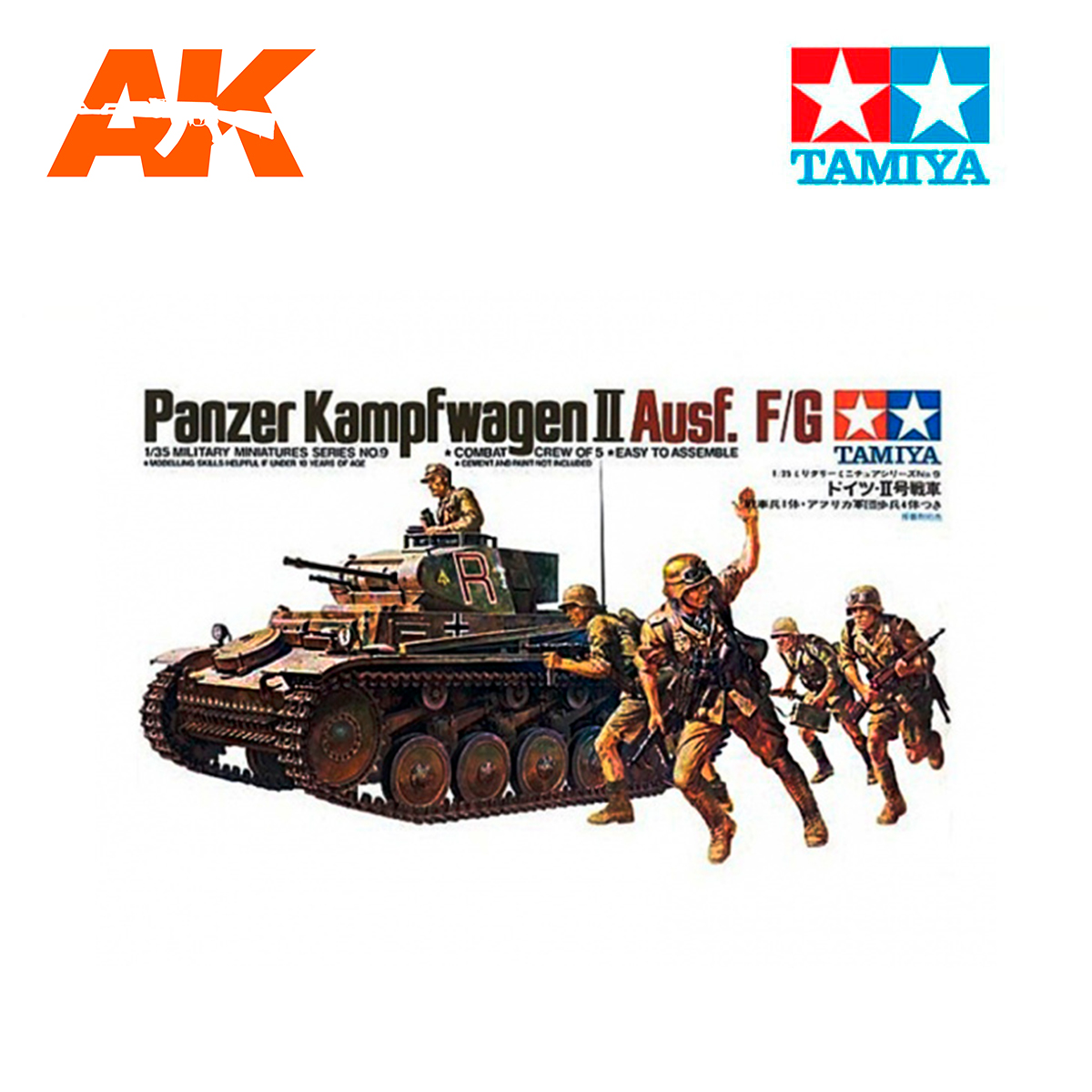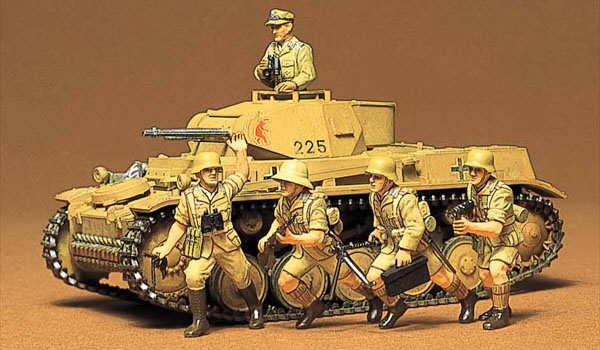1/35 German Panzerkampfwagen II
10,50€
Sin existencias

*Please check our Privacy Policies to see how to we use your personal data.
*Por favor revisa nuestra Política de Privacidad para ver como tratamos tus datos personales
In the morning of September 1, 1939, the German forces consisting of the 3rd, 4th, 8th, 10th and the 14th Armies invaded Poland all heading for Warsaw, its capital. This was the beginning of the 2nd World War that had shaken the whole world for six years and the Germans made a good show of their war efforts at the start with this violent surprise offensive by massed air forces and mechanized ground forces in close co-ordination, the so-called «Blitzkrieg». It was none other than the Pzkpfw 11 that had played the key role in this Blitzkrieg which started with the invasion of Poland to be followed by break-through of the Maginot-line 7 months later and ended with the surrender of France.
In anticipation of the delay in production of the two main strength tanks of the Pzkpfw III and the Pzkpfw IV then under development, the Ordnance Department decided in 1934 to develop a new tank instead to fill the gap. It gave specifications of the proposed new tank to the following three companies – the Mann, the Krupp and the Henschel. The specifications envisioned a tank weighing less than 10 tons and armed with 2 cm and 7.92 mm machine guns, one each. Among the designs of the rivaling three companies presented, the one by the Mann was selected and the Mann in cooperation with the Daimler-Benz developed a first tank of the a1 type in 1935. When 25 tanks of the same type were produced, the tank was officially named, «Panzer Kampfwagen II».
After the first 25, another 25 tanks of the a2 type and 50 of the a3 type were produced in succession by 1936. Tanks of these 3 types thus produced were equipped each with a 6-cylinder, 130HP, May-Bach HL37 engine and credited with a maximum speed of 40km/h. However, it was decried that the horse-power was not enough and the engine was replaced with a May-Bach HL-62 one of 140 HP. The frontal armour, too, was reinforced and a new tank of the b type was produced. In 1937, the Pzkpfw II was further improved and a series of new ones of the c type were produced. The c-type tanks used 5 large sized road wheels suspended only at one end by leaf spring. This suspension system newly introduced became a common feature to all the pzkpfw II produced ever since. Also, the front portion of hull was reshaped into a more roundish form. From 1937 to the beginning of 1940, Pzkpfw II of mass production types, A, B, and C, were manufactured in great numbers. To increase their productivity’s, the frontal armour plate was replaced with an angular single-piece one. Pzkpfw II with specifications described above played the key role in the Blitzkrieg. At the start of this Blitzkrieg, the German tanks numbered 2580 in all, of which nearly half amounting to 955 in number were the Pzkpfw II. In 1940, mass production of the F type was started. The new Pzkpfw II was reinforced in its frontal armour (thickened to 35mm) and side (to 20mm). However, the improvement added its weight and its overall weight reached up to 9.5 tons. The main gun was replaced with a 20mm KwK 30 machine gun. The gun used to be an anti-air MG but remodeled into a main gun for a tank. Frontal armour to cover upper hull, also, was changed into a plain single-piece plate. Further, a false look-out window beside the genuine one for the driver and another for the same were newly added. These were the distinct features of the F-type tanks. After the F-type ones, those of the final mass-production type G were produced. Their main guns were much more powerful KWK 38 MGs, and each tank of this type was fixed a sundries-box at the rear of gun turret. These two were main features that clearly distinguished the G type from the preceding ones.
A series of the Pzkpfw II succeeding those of the g type were produced until those of the L type appeared. However, respective numbers of the Pzkpfw II of types produced were all small. It is true that judged by the current standard, these Pzkpfw II look quite inferior both in fire and defensive powers. But when compared with those of other countries active at the time, the Pzkpfw II should be ranked as by far the most superior one. Indeed, its nimble mobility matching well with the German application was the driving force of the spectacular victory won by the Germans at the initial period of the World War II.
En la mañana del 1 de septiembre de 1939, las fuerzas alemanas compuestas por los ejércitos 3, 4, 8, 10 y 14 invadieron Polonia dirigiéndose todas a Varsovia, su capital. Este fue el comienzo de la 2ª Guerra Mundial, que sacudió al mundo entero durante seis años, y los alemanes dieron una buena muestra de sus esfuerzos bélicos al principio con esta violenta ofensiva por sorpresa de fuerzas aéreas masificadas y fuerzas terrestres mecanizadas en estrecha coordinación, la llamada «Blitzkrieg». Fue nada menos que el Pzkpfw 11 el que jugó el papel clave en esta Blitzkrieg que comenzó con la invasión de Polonia para ser seguida por la ruptura de la línea Maginot 7 meses después y terminó con la rendición de Francia.
En previsión del retraso en la producción de los dos carros de combate de mayor potencia, el Pzkpfw III y el Pzkpfw IV, que se estaban desarrollando en ese momento, el Departamento de Artillería decidió en 1934 desarrollar un nuevo carro de combate para llenar el vacío. Dio las especificaciones del nuevo tanque propuesto a las siguientes tres empresas: la Mann, la Krupp y la Henschel. Las especificaciones preveían un tanque de menos de 10 toneladas y armado con ametralladoras de 2 cm y 7,92 mm, una cada una. Entre los diseños de las tres empresas rivales presentados, se seleccionó el de la Mann y ésta, en colaboración con la Daimler-Benz, desarrolló un primer tanque del tipo a1 en 1935. Cuando se produjeron 25 tanques del mismo tipo, el tanque recibió el nombre oficial de «Panzer Kampfwagen II».
Después de los primeros 25, se produjeron sucesivamente otros 25 tanques del tipo a2 y 50 del tipo a3 hasta 1936. Los tanques de estos 3 tipos así producidos estaban equipados cada uno con un motor May-Bach HL37 de 6 cilindros y 130 CV y se les atribuía una velocidad máxima de 40 km/h. Sin embargo, se denunció que la potencia no era suficiente y el motor fue sustituido por uno May-Bach HL-62 de 140 CV. También se reforzó el blindaje frontal y se fabricó un nuevo tanque del tipo b. En 1937, el Pzkpfw II fue mejorado aún más y se produjo una serie de nuevos del tipo c. Los tanques del tipo c utilizaban 5 ruedas de carretera de gran tamaño suspendidas sólo en un extremo por una ballesta. Este sistema de suspensión recién introducido se convirtió en una característica común a todos los pzkpfw II producidos desde entonces. Además, la parte delantera del casco fue remodelada para darle una forma más redondeada. Desde 1937 hasta principios de 1940, los Pzkpfw II de producción en masa, A, B y C, se fabricaron en gran número. Para aumentar su productividad, se sustituyó el blindaje frontal por uno angular de una sola pieza. Los Pzkpfw II con las especificaciones descritas anteriormente jugaron un papel clave en la Blitzkrieg. Al comienzo de esta Blitzkrieg, los tanques alemanes eran 2580 en total, de los cuales casi la mitad, es decir 955, eran los Pzkpfw II. En 1940 se inició la producción en serie del tipo F. El nuevo Pzkpfw II fue reforzado en su blindaje frontal (engrosado a 35 mm) y lateral (a 20 mm). Sin embargo, esta mejora aumentó su peso y su peso total llegó a ser de 9,5 toneladas. El cañón principal fue sustituido por una ametralladora KwK 30 de 20 mm. El cañón solía ser una MG antiaérea, pero se remodeló en un cañón principal para un tanque. El blindaje frontal para cubrir la parte superior del casco también se cambió por una placa lisa de una sola pieza. Además, se añadió una falsa ventanilla de vigilancia junto a la auténtica para el conductor y otra para el mismo. Estas fueron las características distintivas de los tanques de tipo F. Después de los del tipo F, se produjeron los del tipo G de producción en serie final. Sus cañones principales eran los KWK 38 MG, mucho más potentes, y en cada tanque de este tipo se fijaba una caja de artículos diversos en la parte trasera de la torreta del cañón. Estas dos eran las principales características que distinguían claramente al tipo G de los anteriores.
Se produjeron series de Pzkpfw II que sucedieron a los del tipo G hasta que aparecieron los del tipo L. Sin embargo, los números respectivos de los Pzkpfw II de los tipos producidos fueron todos pequeños. Es cierto que, juzgados por el estándar actual, estos Pzkpfw II parecen bastante inferiores tanto en fuego como en potencia defensiva. Pero si se comparan con los de otros países activos en aquella época, los Pzkpfw II deben ser calificados como los más superiores con diferencia. De hecho, su ágil movilidad, que encaja bien con la aplicación alemana, fue la fuerza motriz de la espectacular victoria obtenida por los alemanes en el período inicial de la Segunda Guerra Mundial.



